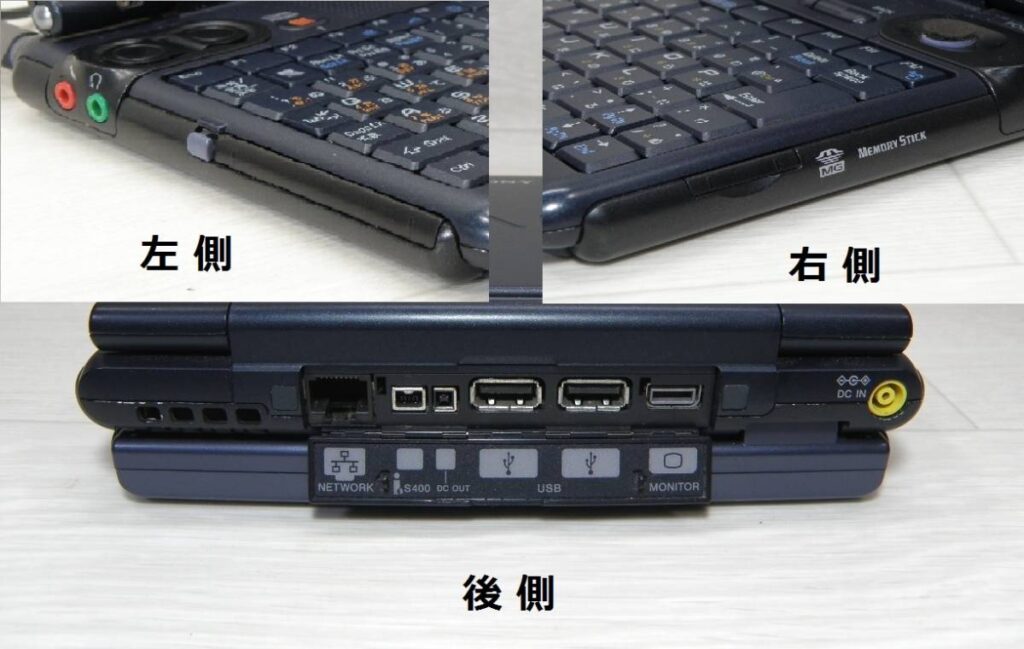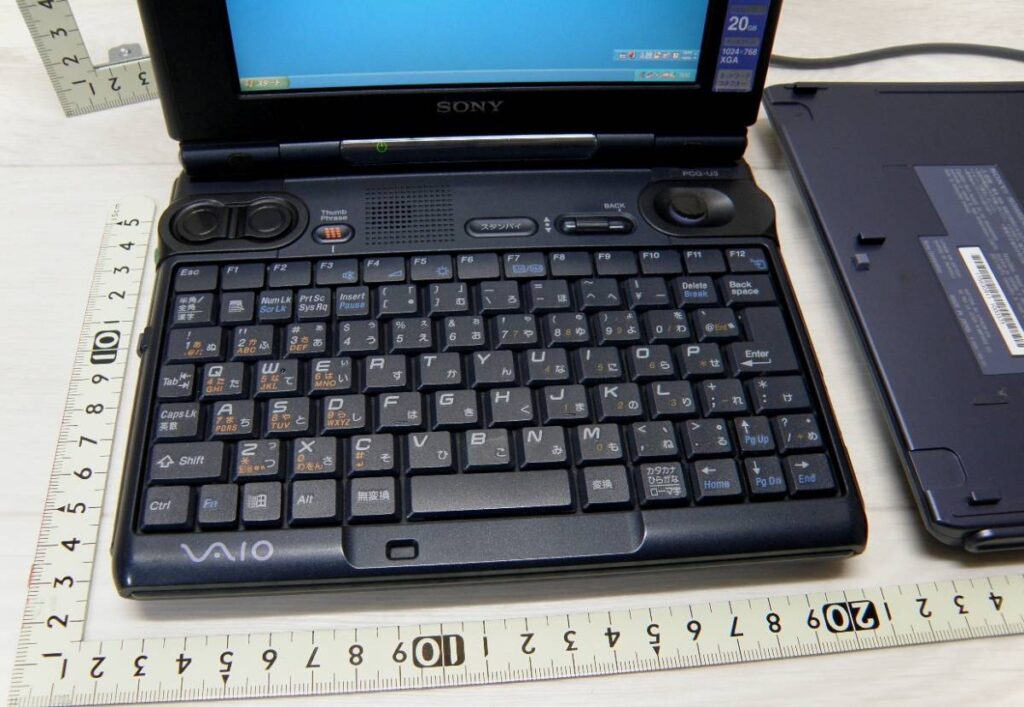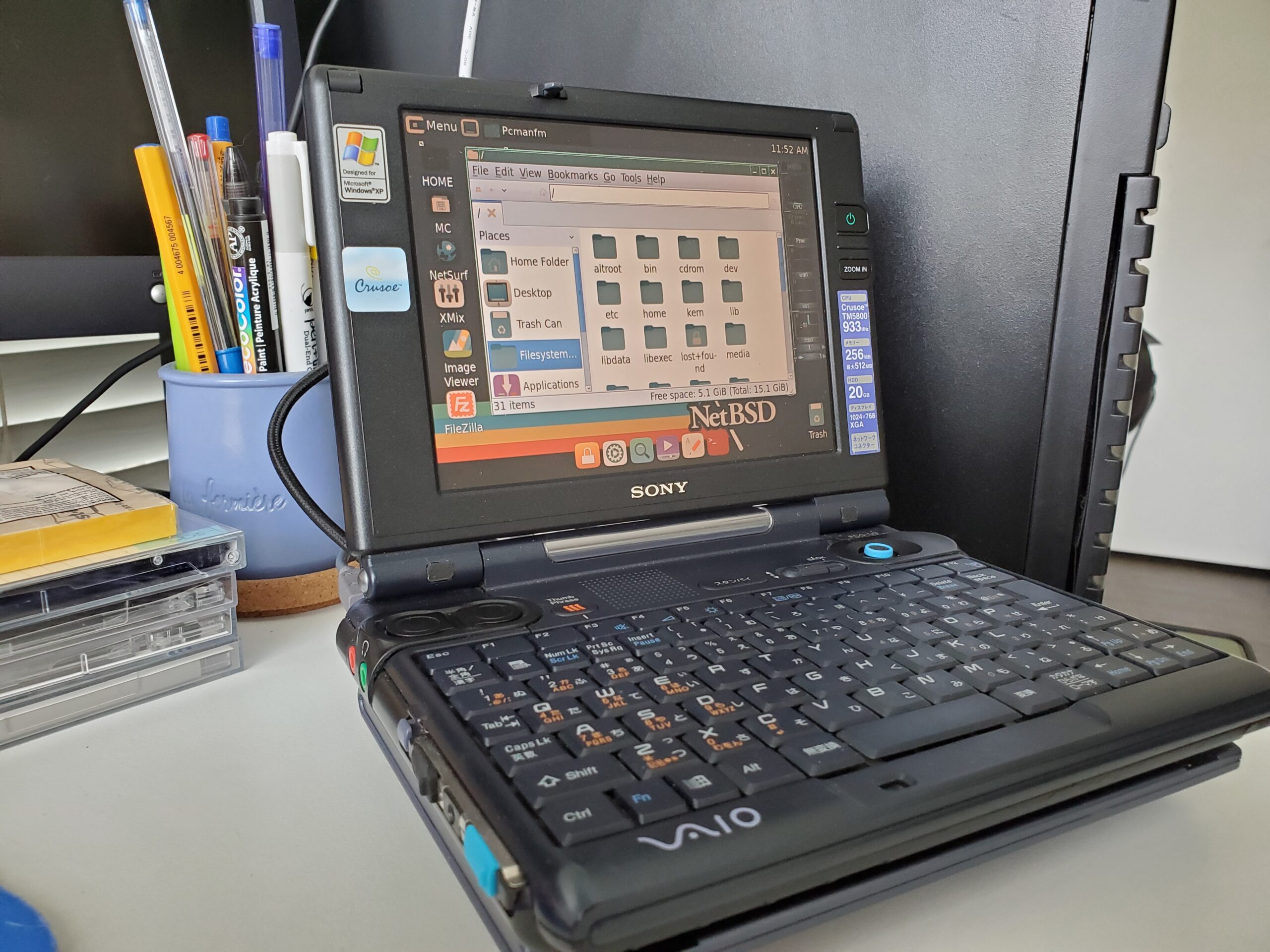
Description
Sony PCG-U3 was selling on Japanese market only circa 2002. Initial price was $1424 about. The ultra sub-notebook weighs just 820 grams. It was designed for Windows XP. It is a quite compact kind of UMPC, i.e. ultra mobile personal computer, equipped with
- Processor Transmeta Crusoe 5800, 933Mhz
- RAM 256MB DDR + additional 256MB memory module can be installed (*)
- Video ATI Mobility Radeon-M 8MB (Dual View Capable)
- Display TFT 6.4 (1024 x 768 internal, 1600 x 1200 external)
- Hard Disk 20GB Ultra ATA
- Audio Mega Bass with Theater sound and built in microphone
- Keyboard 106/109 International Japanese keyboard
- Mouse Jog Type: built in to keyboard
- Ports/Slots (Built In) 2 x USB 1.0
- 1 x iLink (1394 – 4 Pin) Firewire
- 1 x LAN (RJ-45)
- 1 x Biology U Port
- 1 x Headphone Out (Mega Bass)
- 1 x Microphone In
- 1 x Magic Gate Memory Stick Slot
- 1 x Type II PCMCIA
- 1 x Jog Dial
- 1 x Power Button
- 1 x Display Port
So what to do with so outdated UMPC in 2024? There are three options: sell it on eBay, put it on a shelf and look at it, or try to use it with the most up-to-date software. The third way is a kind of challenge and I choose it.
Accessories that are compatible with the PCG-U3 (from a Sony advert. paper with regard to production dates)
- PCGA-CPU1 Sony’s Soft Carrying Case with VAIO in big letters.
- PCGA-CPU2 Sony’s Black Semi-Soft Carrying Case.
- PCGA-BP3U Extended battery for U3 – good for 8-14 hours
- PCGA-BP1U Additional normal battery for U3 – good for 3-5.5 hours
- PCGA-CRWD2 Sony’s Firewire cable-powered DVD & 20x CD-RW Drive
- PCGA-DVRW1 Sony’s Firewire cable-powered DVD-RW Drive
- PCGA-DVD1/A Sony’s Firewire cable-powered DVD-RW Drive
- PCGA-CD51 Sony’s PC Card CD-Rom Drive
- PCGA-AC OEM Spare AC adapter for U-Series, less expensive OEM
- PCGA-AC16V4 Sony made spare AC adapter for U-Series
- PCGA-UFD5 Sony’s USB Floppy drive
- PCGA-BA1 Sony’s Bluetooth adapter for U-Series
- PC-Modem Card Prosonics 56K modem card.
- PCGA-DA1S Sony VGA Adapter for U-Series
- PCGA-UVC11 Sony’s clip-on webcam
- PCGA-SP1 Sony’s Laptop speakers printed with “VAIO”
- PCGA-UMS5 Sony’s USB White Mouse printed with “VAIO”
- PCGA-UMS1/A Sony’s USB Grey Mouse printed with “VAIO”
- PCWA-A500 Sony’s 802.11a High-Speed Wireless (WiFi) Access card
- MZ-N10 Sony’s latest Minidisc player with NET.MD
- PCGA-HDM06 Sony’s Firewire cable-powered external HD Drive
PCG-U3 User manual (Japanese)
Hardware notes
Every CPU needs a good cooling, especially a CPU born around 2002 because of the fully dried thermal paste. There is a good YouTube video on how to disassemble the younger brother of the PCG-U3, the PCG-U1, https://www.youtube.com/watch?v=cuVozDfhCCs. I removed the CPU cooling system and cleaned the CPU with isopropyl alcohol from a thermal strip. Actually, it wasn’t a simple plastic thermal strip. It was a type of strip that had been transformed into a dried, stone-like strip. And then I applied new thermal grease.
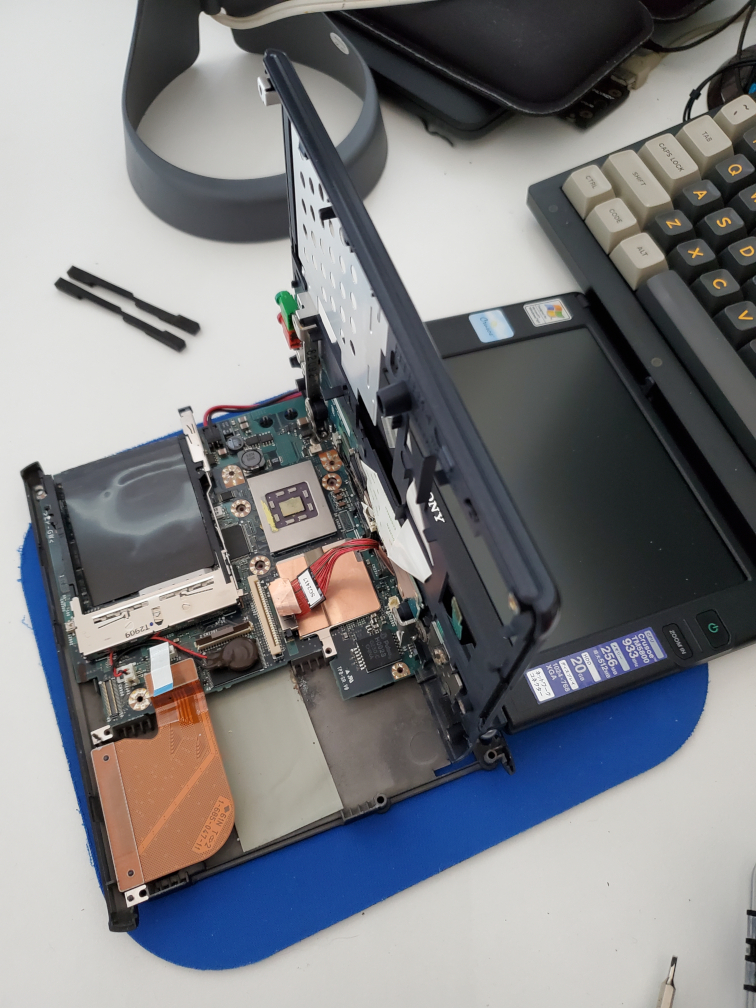
A very rare CPU fan is used. It’s a Toshiba MCF-503PAM05 DC5V 150mA. It seems impossible to find this fan for sale on eBay, whether it’s new or old. It also seems that the fan can’t be removed from the heat sink without being damaged. So the only options are to clean it of dust and lubricate it. I used sewing machine oil.
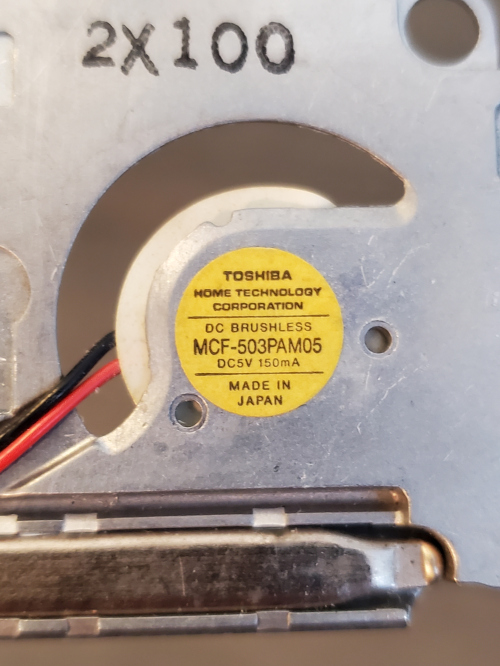
This UMPC uses Panasonic VL-1220(VL-1220/VCN can be used as well) 3V/7mAh CMOS/clock battery. Funny fact: I’ve installed a new VL-1220/VCN, but the internal clock still runs ahead at 4 hours.
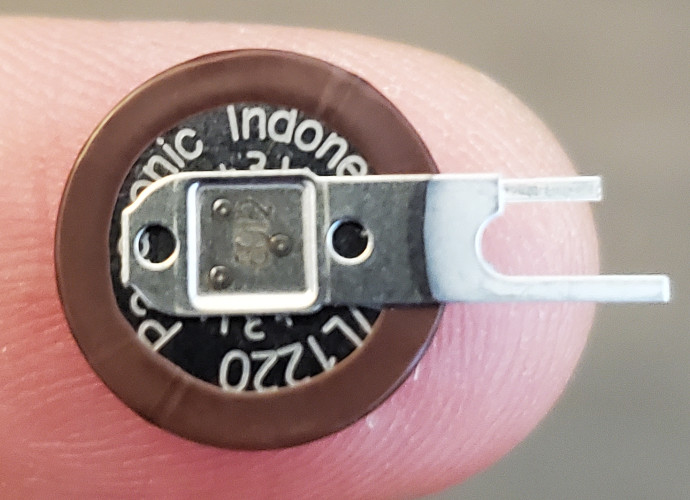
Hard disk drive. By default, the PCG-U3 comes with a Toshiba MK2003GAH 20G IDE drive. I got it old and clicking so much that thoughts of incoming drive dead came into my mind. How to upgrade it? I’m skeptical about using CompactFlash cards with a special CF to IDE adapter, given the very limited number of write cycles CF cards have. SSD use seems to be possible in a way: mSATA drive -> mSATA to ZIF adapter -> ZIF to IDE cable, but I haven’t tested it. I think the best you can do is to upgrade the standard drive with a Toshiba MK6006GAH 60G IDE drive. And that is what I did.
Video. ATI Technologies Radeon Mobility M6 LY is the full name of the video card. It’s an old built-in AGP video card with 8M of RAM and rather questionable driver support. Sony Windows XP (JP) support CD provides Windows drivers for this video card. I had problems with the video card. More on this later.
DVD and CD-ROM. It appears that the PCG-U3 only supports external booting from Sony devices. I have successfully tested booting from a Sony PCGA-CRWD2 Firewire cable powered DVD & 20x CD-RW drive. I’m pretty sure other drives such as Firewire PCGA-DVRW1 and PCGA-DVD1 will also be able to provide external booting. Most likely Sony’s PC Card CD-ROM drive PCGA-CD51 is also external boot compatible. Important: I tested an average no-name USB DVD-ROM drive, and PCG-U3 wasn’t able to boot from it.
Memory. Additional 256M memory module was installed.
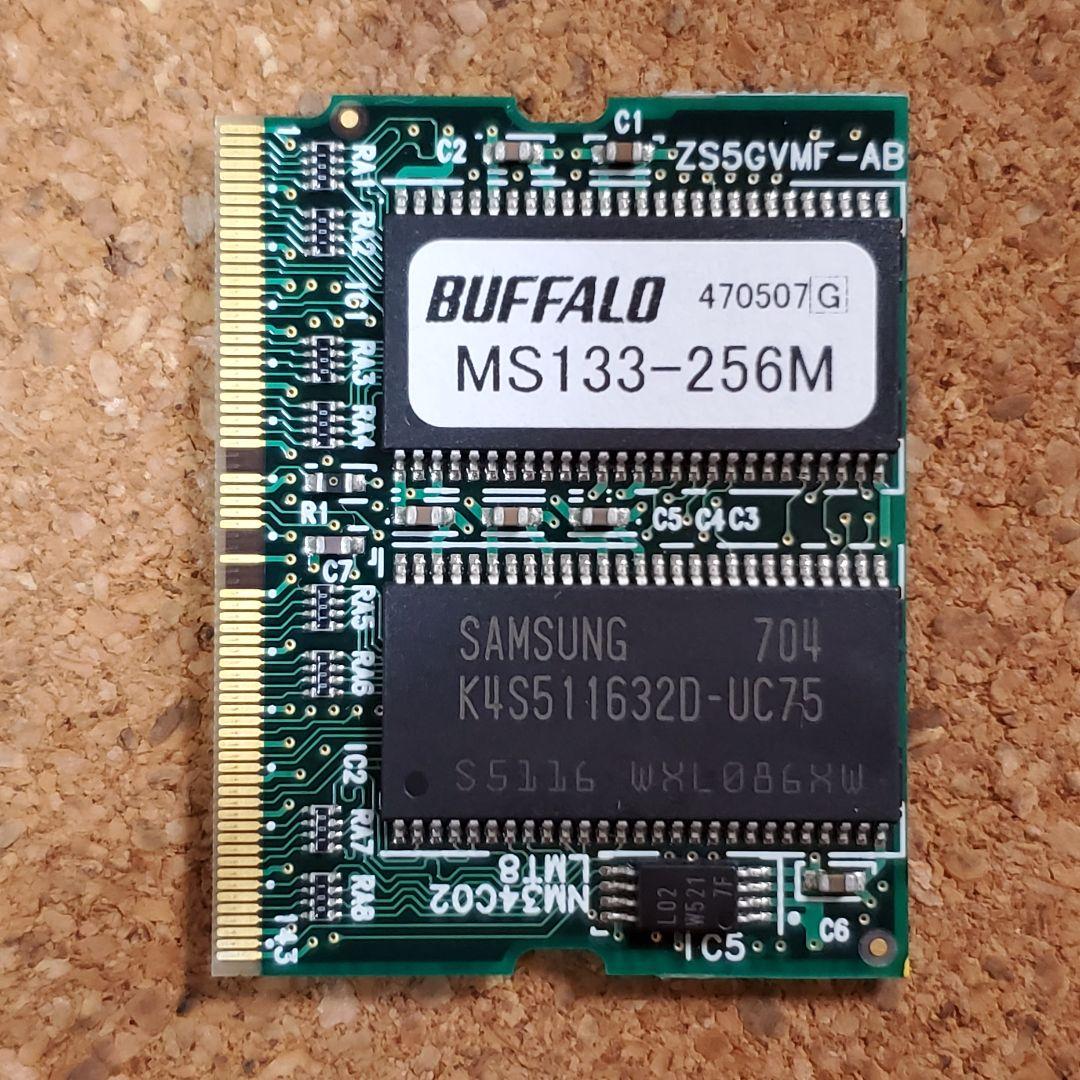
Memory Stick reader. It’s was detected by any of the tested OS. Fortunately only Windows provides full read/write support.
Display port. Requires a mini-VGA to VGA adapter to connect an external display. Apple adapters on eBay are compatible with the PCG-U3 display port.
Biology U Port. Perhaps it’s a wrong English translation from Japanese. Whatever it means in original, in PCG-U3, it’s a port to connect a Sony made Firewire devices without external power supply with a special port cable. No OS drivers are required.
Network is present as a Realtek RTL8139/810x family adapter. No problems detected.
Jog mouse, built-in USB, built-in IEE1394 adaptor, PCMCIA slot, sound card. All this stuff was working with any of the tested OS.
Reset button.
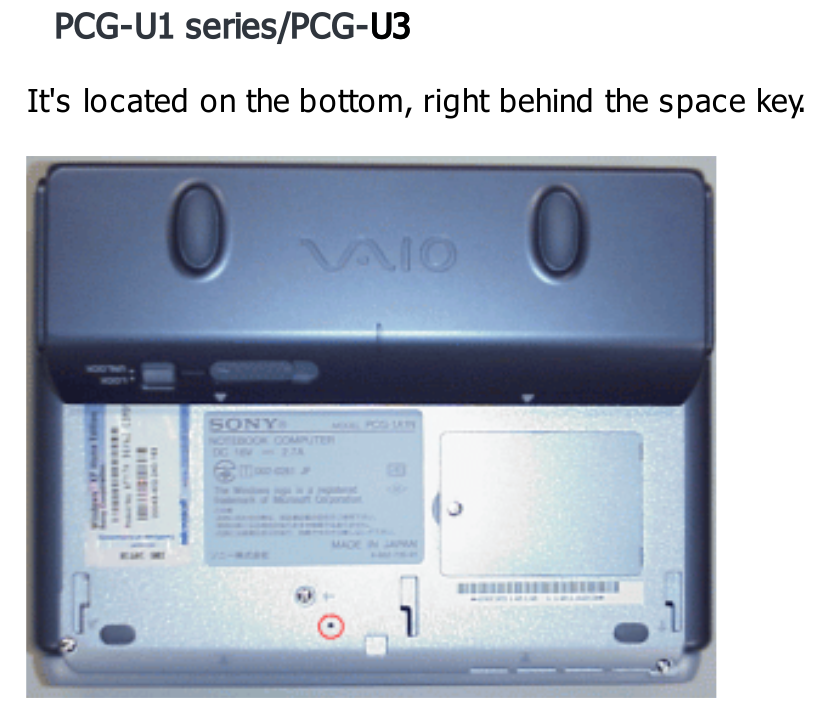
Special buttons
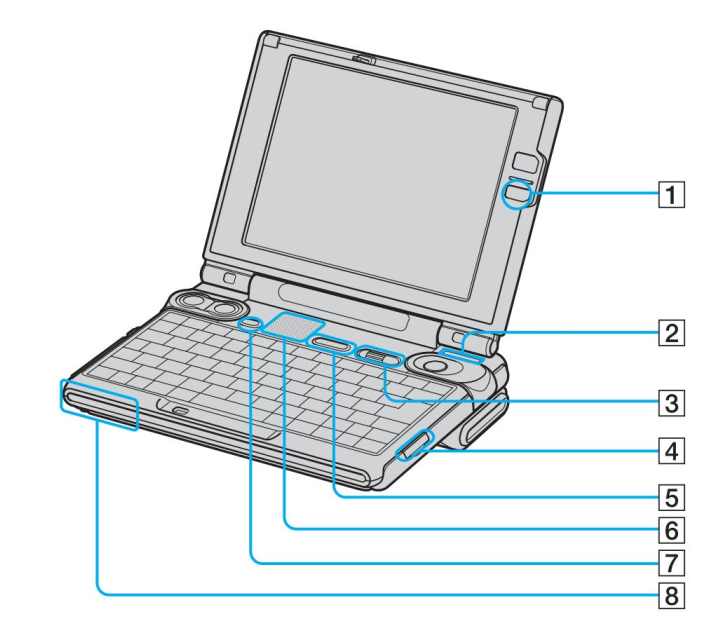
- 1 – Zoom button. It changes screen resolution (*)
- 3 – Jog dial or Back button (*). The jog dial can be used to perform some operations in each software, such as scrolling windows and selecting items. The BACK button is used when you want to return to the previous level while operating the jog dial, or when you want to delete characters while operating the ThumbPhrase software.
- 4 – Standby button to reach the power-saving operation mode (*)
- 6 – ThumbPhrase button (*) to use included “ThumbPhrase” software. It is software that allows you to enter text using simple keystrokes, just like on a mobile phone. You can enter data while holding the device with both hands (mobile grip style), making it easy to use outdoors. In addition, the ThumbPhrase” software uses a predictive conversion function to predict and display conversion candidates based on the characters entered. Predictive conversion has a learning function so that characters entered once are prioritized and displayed as conversion candidates the next time (*)
* – Windows only out-of-the box
Operating system
This UMPC was born to run Windows XP (JP). There are only 256M of RAM + possible installation of 256M extension card. Any Windows XP is out of support for years. From 202* years’ stand point any Windows XP has problems with security.
My target was a 32-bit OS, running on no-PAE CPU, still having community support, relatively fresh, providing maximum, for this UMPC hardware, support and 256M of RAM should be enough to run it.
Which operating system to choose? I did not want to go with Windows: it will either be outdated or slow. No desire to use any of the OS/2 family, even a fresh variant like ArcaOS. I just don’t like all that 32-bit DOS-mixing stuff. Kolibri OS? An OS written in assembler. It works. It is fast. But it can’t handle CPU frequency. I got constant hot air from the cooling fan when running Kolibri OS on PCG-U3. Also, Kolibri OS has no ssh client. That’s critical for me. Not all hardware is supported. The software available is very limited. So no KolibriOS. Haiku OS? It’s a new version of BeOS. The 32-bit version requires the PAE extension. So not a Haiku OS. So it should be an ether OS from the Linux or *BSD families.
Linux. There are only two variants: Gentoo (any release) or Debian 8. I do not have the patience to build an OS from scratch on such a slow CPU, so Gentoo is not my choice. Debian 8 is relatively new. I successfully installed it on the PCG-U3, but after that I couldn’t get the X server to boot properly. All I got was a blank screen in VESA mode. So Debian wasn’t selected.
BSD family. Which one? FreeBSD? The last one with no-PAE support was v. 12. The installation is quite complicated and requires the presence of a boot CD-ROM and a boot USB flash drive. After installation, the firewire adapter wasn’t detected. All binary ports have been removed from the FreeBSD repository as of 1 January 2024. So no FreeBSD. OpenBSD? It seems to me that 32-bit architecture support is sporadic in this project these days, and was only limited by the outdated v.4 version. NetBSD? Version 9.3 was released on 22 August 2022. It’s quite fresh. The upcoming version 10 promises to continue 32-bit support. Let’s give it a try.
Windows XP note
Sony Vaio PCG-U3 driver backup CD is still available for download from the Internet Archive site.
NetBSD 9.3 i386
PCG-U3 can run NetBSD 9.* and 10.* families and most of PCG-U3 hardware are supported. Installation is fairly straightforward, at least if you’re an intermediate UNIX user, i.e.
- burn NetBSD bootable CD or DVD
- boot from the bootable disk
- follow the document https://www.netbsd.org/docs/guide/en/chap-exinst.html
How it looks like
Screenshots are taken in 800×600 resolution. All whistles and bangles you see below are not out-of-the-box. It’s a deep customization.
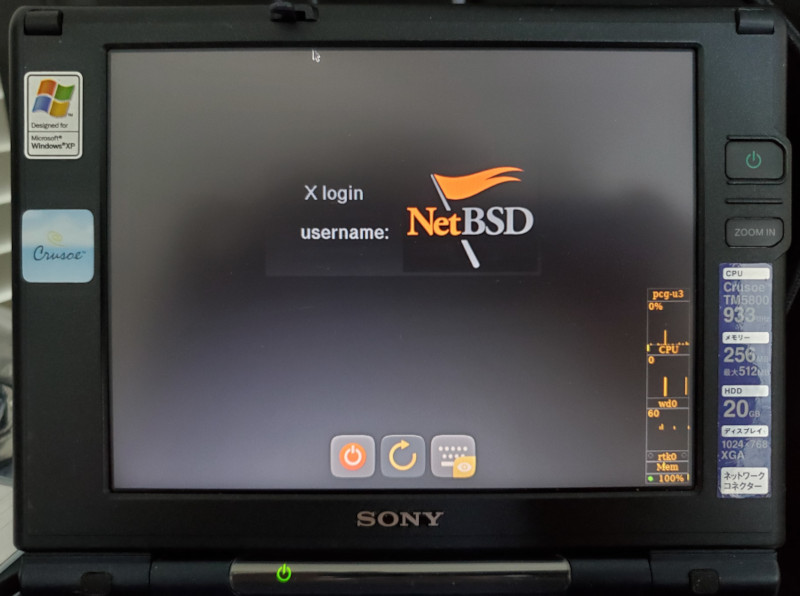
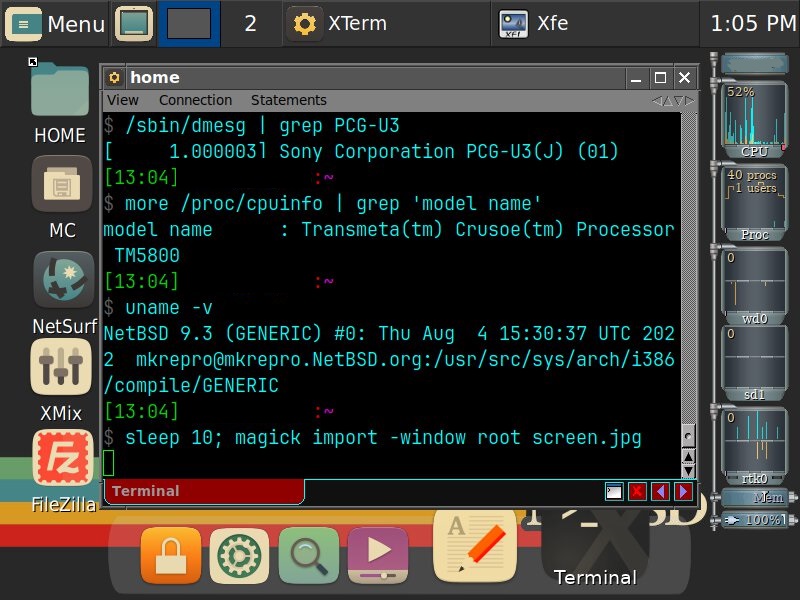
BIOS
The “Plug & Play O/S” option on the “Advanced” page must be set to “NO”. Otherwise the NetBSD “poweroff” command will cause the kernel to panic and reboot.
Tested additional hardware
- USB 2.0 cardbus adapter Adaptect AHA-1420A(*)
- USB 2.0 cardbus adapter Area SD-CBU2-Z1(*)
- 10/100 Ethernet cardbus adapter Buffalo LPC5-CLX-C8(*)
- WIFI cardbus adapter 3Com 3CRXJK10075(*)
- WIFI USB adapter Buffalo WLI-UC-GN(*)
- Bluetooth adapter ASUS USB-BT400(*)
- USB soundcard Creative Sound Blaster PLAY! 3(*)
- Magneto-optical Firewire drive FUJITSU MDF3130EE(*)
- CD-RW/DVD Firewire drive Sony PCGA-CRWD2(*)
- Apple 603-0607 Mini-VGA to VGA adapter(*)
- Logitech HD Webcam C270 (*)
- External HD Firewire drive Sony PCGA-HDM06 (*)
- USB security token YubiKey 5C
* – right out-of-the-box drivers
List of all attached PCI devices including USB cardbus adapter from the NetBSD OS stand point
[19:34] user@hostname:~
$ pcictl pci0 list
000:00:0: Transmeta LongRun North Bridge (host bridge, revision 0x03)
000:00:1: Transmeta SDRAM Controller (RAM memory)
000:00:2: Transmeta BIOS Scratchpad (RAM memory)
000:06:0: Acer Labs M5451 AC-Link Controller Audio Device (audio multimedia, revision 0x02)
000:07:0: Acer Labs M1533 PCI-ISA Bridge (ISA bridge)
000:09:0: Texas Instruments TSB43AA22/A IEEE 1394 Host Controller (IEEE1394 serial bus, OpenHCI)
000:11:0: Realtek Semiconductor 8139 10/100 Ethernet (ethernet network, revision 0x10)
000:12:0: ATI Technologies Radeon Mobility M6 LY (VGA display)
000:15:0: Acer Labs M5237 USB 1.1 Host Controller (USB serial bus, OHCI, revision 0x03)
000:16:0: Acer Labs M5229 UDMA IDE Controller (IDE mass storage, interface 0xe0, revision 0xc4)
000:17:0: Acer Labs M7101 Power Management Controller (miscellaneous prehistoric)
000:18:0: Ricoh 5C475 PCI-CardBus Bridge (CardBus bridge, revision 0x80)
000:20:0: Acer Labs M5237 USB 1.1 Host Controller (USB serial bus, OHCI, revision 0x03)
001:00:0: NEC USB Host Controller (USB serial bus, OHCI, revision 0x43)
001:00:1: NEC USB Host Controller (USB serial bus, OHCI, revision 0x43)
001:00:2: NEC USB2 Host Controller (USB serial bus, EHCI, revision 0x04)
Software on the screenshots
- XDM – X login manager
- WBar – quick-launch tool bar on the bottoms
- GKRellm – CPU, RAM, Disk, Ethernet activity monitor
- JWM – window manager and panel
- LXDE – desktop environment
Memory consumption and CPU load right after logon to LXDE (512M RAM is available)
load averages: 0.45, 0.30, 0.26; up 0+03:11:34 18:43:00
50 processes: 49 sleeping, 1 on CPU
CPU states: 2.3% user, 0.0% nice, 0.3% system, 0.3% interrupt, 97.3% idle
Memory: 183M Act, 484K Inact, 11M Wired, 51M Exec, 77M File, 218M Free
Swap: 2048M Total, 2048M Free
PID USERNAME PRI NICE SIZE RES STATE TIME WCPU CPU COMMAND
1756 user 85 0 8008K 3244K wait 0:00 3.90% 2.15% bash
2107 root 85 0 15M 5884K select 0:01 2.19% 1.56% sshd
1761 user 42 0 36M 16M parked 0:42 0.34% 0.34% gkrellm
0 root 96 0 0K 30M smtaskq 5:34 0.00% 0.00% [system]
535 root 85 0 128M 40M select 2:16 0.00% 0.00% X
486 root 85 0 16M 2340K nanoslp 1:29 0.00% 0.00% pcscd
2065 user 43 0 40M 16M parked 0:14 0.00% 0.00% jwm
442 root 85 0 11M 11M pause 0:10 0.00% 0.00% ntpd
1167 user 85 0 76M 27M select 0:09 0.00% 0.00% pcmanfm
549 root 85 0 17M 8132K wait 0:02 0.00% 0.00% xdm
975 user 85 0 14M 4356K select 0:02 0.00% 0.00% sshd
973 user 85 0 6900K 2168K select 0:02 0.00% 0.00% top
1568 user 84 0 37M 11M select 0:02 0.00% 0.00% lxsession
2117 root 85 0 14M 5880K select 0:01 0.00% 0.00% sshd
1368 user 85 0 20M 5528K select 0:01 0.00% 0.00% gvfsd-trash
670 user 85 0 14M 4356K select 0:01 0.00% 0.00% sshd
1598 user 85 0 7776K 2268K nanoslp 0:01 0.00% 0.00% xautolock
1387 user 84 0 33M 9036K select 0:01 0.00% 0.00% lxclipboard
2079 root 84 0 14M 5772K select 0:01 0.00% 0.00% sshd
516 root 84 0 14M 5684K select 0:01 0.00% 0.00% sshd
1497 user 83 0 17M 10M select 0:01 0.00% 0.00% wbar
725 user 83 0 7776K 3232K wait 0:01 0.00% 0.00% bash
2292 user 43 0 7092K 2164K CPU 0:00 0.00% 0.00% top
2102 user 85 0 15M 4284K select 0:00 0.00% 0.00% sshd
xorg.conf file
You need to create it manually if you don’t want to use VESA mode
Section "Device"
Identifier "Card0"
Driver "radeon" <<-- exactly this driver must be used
Option "BusType" "PCI"
Option "DPI" "96 x 96"
Next step is to replace default radeon driver file with the old one. A working example:
[20:01] user@hostname:/usr/X11R7/lib/modules/drivers
$ ls -la | grep radeon
lrwxr-xr-x 1 root wheel 19 Feb 4 10:03 radeon_drv.so -> radeon_drv_old.so.6
-r--r--r-- 1 root wheel 517804 Aug 4 2022 radeon_drv.so.19_new
lrwxr-xr-x 1 root wheel 19 Aug 4 2022 radeon_drv_old.so -> radeon_drv_old.so.6
-r--r--r-- 1 root wheel 1107556 Aug 4 2022 radeon_drv_old.so.6
to reach the target
[20:04] user@hostname:/var/log
$ more Xorg.0.log | grep -i radeon
[ 86.303] (II) LoadModule: "radeon"
[ 86.307] (II) Loading /usr/X11R7/lib/modules/drivers/radeon_drv.so
[ 86.382] (II) Module radeon: vendor="X.Org Foundation"
[ 86.445] (II) RADEON: Driver for ATI Radeon chipsets:
...
ATI Radeon X850 PRO (R480) (AGP), ATI Radeon X850 XT PE (R480) (AGP),
ATI Radeon Mobility M7 LW (AGP),
ATI Radeon Mobility M6 LY (AGP)
ATI Radeon Mobility 9000 (M9) Lf (AGP),
...
[ 86.693] (II) RADEON(0): TOTO SAYS 00000000e8000000
[ 86.695] (II) RADEON(0): MMIO registers at 0x00000000e8000000: size 64KB
[ 86.701] (II) RADEON(0): PCI bus 0 card 12 func 0
[ 86.713] (**) RADEON(0): Depth 24, (--) framebuffer bpp 32
[ 86.713] (II) RADEON(0): Pixel depth = 24 bits stored in 4 bytes (32 bpp pixmaps)
[ 86.713] (==) RADEON(0): Default visual is TrueColor
[ 86.715] (**) RADEON(0): Option "SWcursor" "off"
[ 86.716] (**) RADEON(0): Option "BusType" "PCI"
[ 86.716] (**) RADEON(0): Option "AGPMode" "4"
[ 86.717] (**) RADEON(0): Option "AGPFastWrite" "on"
[ 86.717] (**) RADEON(0): Option "EnablePageFlip" "on"
[ 86.717] (**) RADEON(0): Option "RenderAccel" "on"
[ 86.719] (**) RADEON(0): Option "AccelMethod" "XAA"
[ 86.746] (II) RADEON(0): vgaHWGetIOBase: hwp->IOBase is 0x03d0
[ 86.748] (==) RADEON(0): RGB weight 888
[ 86.749] (II) RADEON(0): Using 8 bits per RGB (8 bit DAC)
[ 86.749] (--) RADEON(0): Chipset: "ATI Radeon Mobility M6 LY (AGP)" (ChipID = 0x4c59)
[ 86.750] (--) RADEON(0): Linear framebuffer at 0x00000000f0000000
[ 86.750] (II) RADEON(0): PCI card detected
[ 86.750] (**) RADEON(0): Forced into PCI mode
[ 86.759] (II) RADEON(0): initializing int10
[ 86.775] (II) RADEON(0): Primary V_BIOS segment is: 0xc000
[ 86.801] (II) RADEON(0): Legacy BIOS detected
[ 86.819] (II) RADEON(0): Detected total video RAM=8192K, accessible=65536K (PCI BAR=131072K)
[ 86.820] (--) RADEON(0): Mapped VideoRAM: 8192 kByte (32 bit DDR SDRAM)
[ 86.820] (II) RADEON(0): Color tiling enabled by default
[ 86.826] (II) RADEON(0): ref_freq: 2700, min_out_pll: 12000, max_out_pll: 35000, min_in_pll: 40, max_in_pll: 3000, xclk: 16600, sclk: 166.000000, mclk: 166.000000
[ 86.826] (II) RADEON(0): PLL parameters: rf=2700 rd=60 min=12000 max=35000; xclk=16600
[ 86.830] (II) RADEON(0): Panel ID string: 1024x768
[ 86.830] (II) RADEON(0): Panel Size from BIOS: 1024x768
[ 86.830] (II) RADEON(0): BIOS provided dividers will be used.
[ 86.832] (WW) RADEON(0): LVDS Info:
[ 86.832] (WW) RADEON(0): LCD DDC Info Table found!
[ 86.833] (II) RADEON(0): Output VGA-0 using monitor section Monitor0
[ 86.844] (II) RADEON(0): I2C bus "VGA-0" initialized.
[ 86.845] (II) RADEON(0): Output LVDS has no monitor section
[ 86.846] (II) RADEON(0): I2C bus "LVDS" initialized.
[ 86.846] (II) RADEON(0): Output S-video has no monitor section
[ 86.846] (II) RADEON(0): Default TV standard: NTSC
[ 86.846] (II) RADEON(0): TV standards supported by chip: NTSC PAL
[ 86.848] (II) RADEON(0): Port0:
[ 86.849] (II) RADEON(0): Port1:
[ 86.850] (II) RADEON(0): Port2:
[ 86.854] (II) RADEON(0): I2C device "VGA-0:ddc2" registered at address 0xA0.
[ 86.944] (II) RADEON(0): Output: VGA-0, Detected Monitor Type: 0
[ 86.945] (II) RADEON(0): I2C device "LVDS:ddc2" registered at address 0xA0.
[ 86.949] (II) RADEON(0): Output: LVDS, Detected Monitor Type: 2
[ 86.950] (II) RADEON(0): Output: S-video, Detected Monitor Type: 0
[ 87.036] (II) RADEON(0): Output: VGA-0, Detected Monitor Type: 0
[ 87.039] (II) RADEON(0): EDID for output VGA-0
[ 87.088] (II) RADEON(0): Output: LVDS, Detected Monitor Type: 2
[ 87.145] (II) RADEON(0): Added native panel mode: 1024x768
[ 87.146] (II) RADEON(0): Printing probed modes for output LVDS
[ 87.147] (II) RADEON(0): Modeline "800x600"x59.9 38.25 800 832 912 1024 600 603 607 624 -hsync +vsync (37.4 kHz UeP)
[ 87.147] (II) RADEON(0): Modeline "1024x768"x60.0 65.00 1024 1040 1176 1344 768 770 776 806 (48.4 kHz eP)
[ 87.148] (II) RADEON(0): Modeline "640x480"x59.4 23.75 640 664 720 800 480 483 487 500 -hsync +vsync (29.7 kHz e)
[ 87.148] (II) RADEON(0): Output: S-video, Detected Monitor Type: 0
[ 87.149] (II) RADEON(0): EDID for output S-video
[ 87.149] (II) RADEON(0): Output VGA-0 disconnected
[ 87.149] (II) RADEON(0): Output LVDS connected
[ 87.149] (II) RADEON(0): Output S-video disconnected
[ 87.150] (II) RADEON(0): Using user preference for initial modes
[ 87.150] (II) RADEON(0): Output LVDS using initial mode 800x600 +0+0
[ 87.151] (==) RADEON(0): DPI set to (96, 96)
[ 87.225] (==) RADEON(0): Using gamma correction (1.0, 1.0, 1.0)
[ 87.226] (==) RADEON(0): Using EXA acceleration architecture
[ 87.289] (==) RADEON(0): Assuming overlay scaler buffer width is 1536
[ 87.289] (II) RADEON(0): No MM_TABLE found - assuming CARD is not TV-in capable.
[ 87.291] (!!) RADEON(0): MergedFB support has been removed and replaced with xrandr 1.2 support
[ 87.363] (II) RADEON(0): RADEONScreenInit f0000000 0 0
[ 88.045] (II) RADEON(0): Dynamic Power Management Disabled
[ 88.106] (II) RADEON(0): RADEONInitMemoryMap() :
[ 88.107] (II) RADEON(0): mem_size : 0x04000000
[ 88.107] (II) RADEON(0): MC_FB_LOCATION : 0xf3fff000
[ 88.107] (II) RADEON(0): MC_AGP_LOCATION : 0xffffffc0
[ 88.107] (II) RADEON(0): Depth moves disabled by default
[ 88.147] (II) RADEON(0): Allocating from a screen of 8192 kb
[ 88.148] (II) RADEON(0): Will use 32 kb for hardware cursor 0 at offset 0x00400000
[ 88.148] (II) RADEON(0): Will use 32 kb for hardware cursor 1 at offset 0x00404000
[ 88.149] (II) RADEON(0): Will use 4096 kb for front buffer at offset 0x00000000
[ 88.149] (II) RADEON(0): Will use 4064 kb for X Server offscreen at offset 0x00408000
[ 88.200] (II) RADEON(0): RADEONRestoreMemMapRegisters() :
[ 88.200] (II) RADEON(0): MC_FB_LOCATION : 0xf3fff000 0xffff0000
[ 88.200] (II) RADEON(0): MC_AGP_LOCATION : 0xffffffc0
[ 88.934] (==) RADEON(0): Backing store enabled
[ 88.935] (WW) RADEON(0): Direct rendering disabled <<-- pitty :(
[ 88.950] (II) RADEON(0): Render acceleration enabled for R100 type cards.
[ 88.950] (II) RADEON(0): Setting EXA maxPitchBytes
[ 89.013] (II) RADEON(0): Acceleration enabled
[ 89.013] (==) RADEON(0): DPMS enabled
[ 89.013] (==) RADEON(0): Silken mouse enabled
[ 89.165] (II) RADEON(0): Detected Radeon Mobility M6, disabling multimedia i2c
[ 89.175] (EE) RADEON: Failed to load module "theatre_detect" (module does not exist, 0)
[ 89.175] (EE) RADEON(0): Unable to load Rage Theatre detect module
[ 89.179] (II) RADEON(0): Set up overlay video
[ 89.181] (II) RADEON(0): Set up textured video
[ 89.207] (II) RADEON(0): [XvMC] Associated with Radeon Textured Video.
[ 89.207] (II) RADEON(0): [XvMC] Extension initialized.
[ 89.576] (II) RADEON(0): RADEONRestoreMemMapRegisters() :
[ 89.576] (II) RADEON(0): MC_FB_LOCATION : 0xf3fff000 0xf3fff000
[ 89.576] (II) RADEON(0): MC_AGP_LOCATION : 0xffffffc0
[ 89.907] (WW) RADEON(0): Option "DPI" is not used
[ 89.907] (WW) RADEON(0): Option "DynamicClocks" is not used
[ 89.908] (WW) RADEON(0): Option "BIOSHotkeys" is not used
[ 89.908] (WW) RADEON(0): Option "DDCMode" is not used
[ 96.587] (II) RADEON(0): Setting screen physical size to 211 x 158
Keyboard
As you can see PCG-U3 is equipped with a Japanese layout keyboard. So for X Window system
$ setxkbmap -model jp106 -layout jp
and for console
$ echo 'encoding jp' >> /etc/wscons.conf
Sound card
Built-in sound card works, but with the good audible distortions. And that’s why: NetBSD recognizes the sound card as a Yamaha-like sound card, but it’s an ALi sound card. I tried to increase the buffer size in XMMS player, but the distortions didn’t go. So USB soundcard Creative Sound Blaster PLAY! 3 is a cheep way to get more clear sound and it works right out-of-the-box.
More pics
